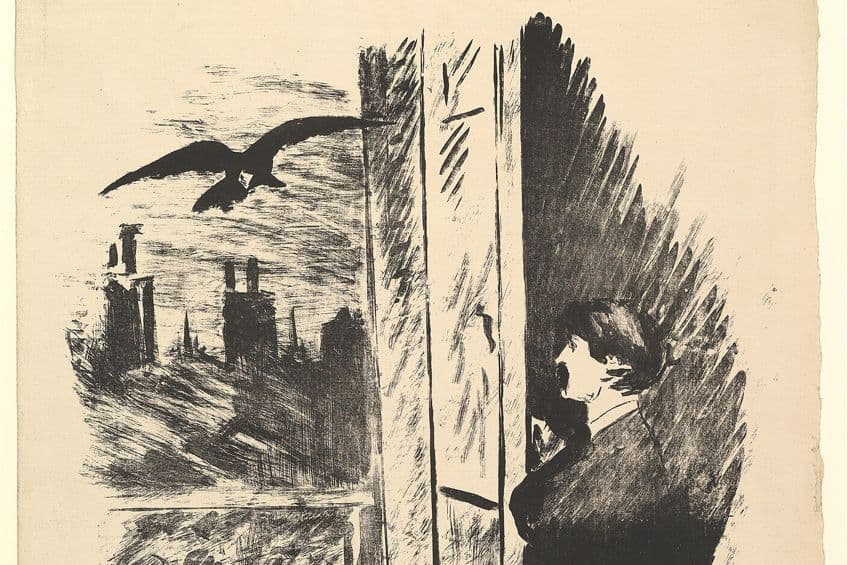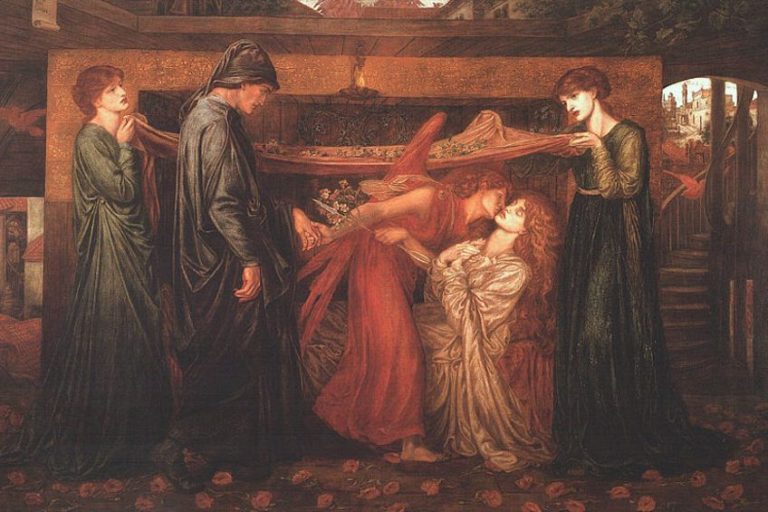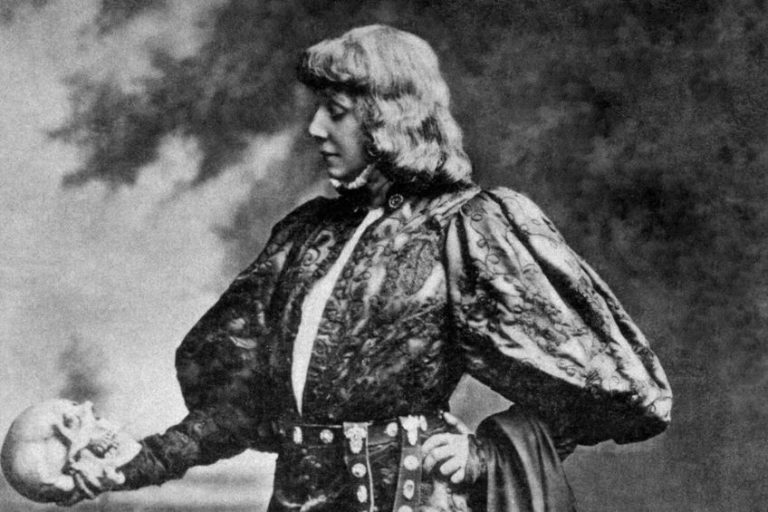“The Raven” by Edgar Allan Poe Analysis – Taking a Closer Look
Few poems have managed to achieve the kind of mainstream fame that The Raven by Edgar Allan Poe has attained. This is often considered to be one of the most famous poems of all time and an important work in the history of Gothic literature. The dark and brooding tone, with its highly musical structure, has become one of the most important aspects of this poem. So, what is The Raven about? That is what we need to discover today. We will briefly look at the biography of the poet before moving to an in-depth analysis of The Raven by Edgar Allan Poe. Let’s get this analysis underway!
Table of Contents
- 1 The Raven by Edgar Allan Poe Analysis
- 2 Summary of The Raven by Edgar Allan Poe
- 3 Biography of Edgar Allan Poe
- 4 An In-Depth The Raven by Edgar Allan Poe Analysis
- 4.1 Stanza One
- 4.2 Stanza Two
- 4.3 Stanza Three
- 4.4 Stanza Four
- 4.5 Stanza Five
- 4.6 Stanza Six
- 4.7 Stanza Seven
- 4.8 Stanza Eight
- 4.9 Stanza Nine
- 4.10 Stanza Ten
- 4.11 Stanza Eleven
- 4.12 Stanza Twelve
- 4.13 Stanza Thirteen
- 4.14 Stanza Fourteen
- 4.15 Stanza Fifteen
- 4.16 Stanza Sixteen
- 4.17 Stanza Seventeen
- 4.18 Stanza Eighteen
- 5 Frequently Asked Questions
The Raven by Edgar Allan Poe Analysis
| Date Published | 1845 |
| Type of Poem | Narrative poem |
| Rhyme Scheme | ABCBBB |
| Meter | Trochaic octameter |
| Topic | Grief and loss |
It is very likely that The Raven is the most famous poem by Edgar Allan Poe. This particular poem is one of the most taught in both high school and university settings and it has come to be seen as one of the central poems in the establishment and development of gothic literature. It is a narrative poem that explores grief and loss through the lens of a raven who has decided to visit a man in mourning. However, we are going to get into an in-depth The Raven by Edgar Allan Poe analysis shortly.

Summary of The Raven by Edgar Allan Poe
Before we get started with this article, it would be beneficial to provide a summary of The Raven by Edgar Allan Poe for those who may not have the time for all of it.
This will be a short list of items worth keeping in mind when examining this particular poem.
- The poem makes use of a gothic tone: This poem is one of the most notable examples of gothic poetry, and this means that it has a more horror-style tone throughout. It makes use of motifs like darkness, mystery, and an inconclusive ending to draw the reader into this feeling.
- The poem is a narrative poem: This means that the poem tells a story. This also means that it uses narrative techniques. For instance, the poem makes extensive use of anticipation. We are never given information quickly and are instead expected to wait for it.
- The poem uses musical-style repetition: This can be seen throughout the poem in the use of rhyme, alliteration, and consonance. There are various end-rhymes and internal rhymes used throughout the poem, and the use of sounds, such as the “p” in “tapping” and “rapping”.
- The poem uses the rhyme of Lenore: The main character in this poem has recently lost the love of his life, Lenore. The poem constantly uses rhymes, like “nevermore” and “nothing more” to draw attention to this name and emphasize it above everything else.
This has been a brief summary of The Raven by Edgar Allan Poe. While this has only been a few short points about The Raven poem’s meanings, themes, and poetic devices, it should provide a good general overview of the poem for those who need it, especially those who are studying this poem.
Biography of Edgar Allan Poe
| Poetic Movement | Romanticism and Gothic literature |
| Years | 1809 – 1849 |
| Place of Birth | Boston, Maryland, United States |
| Known For | The Masque of the Red Death (1842), The Raven (1845), and The Cask of Amontillado (1846). |
Edgar Allan Poe was an incredibly influential writer in American history. While The Raven, which will be our focus today, is definitely his most famous poem and possibly also his most famous text in general, Edgar Allan Poe was likely more influential in prose. His most legendary accomplishment in retrospect is that he was the originator of the detective genre in fiction. For this very simple reason, he is an incredibly important figure in world literature, and his influence cannot be understated.
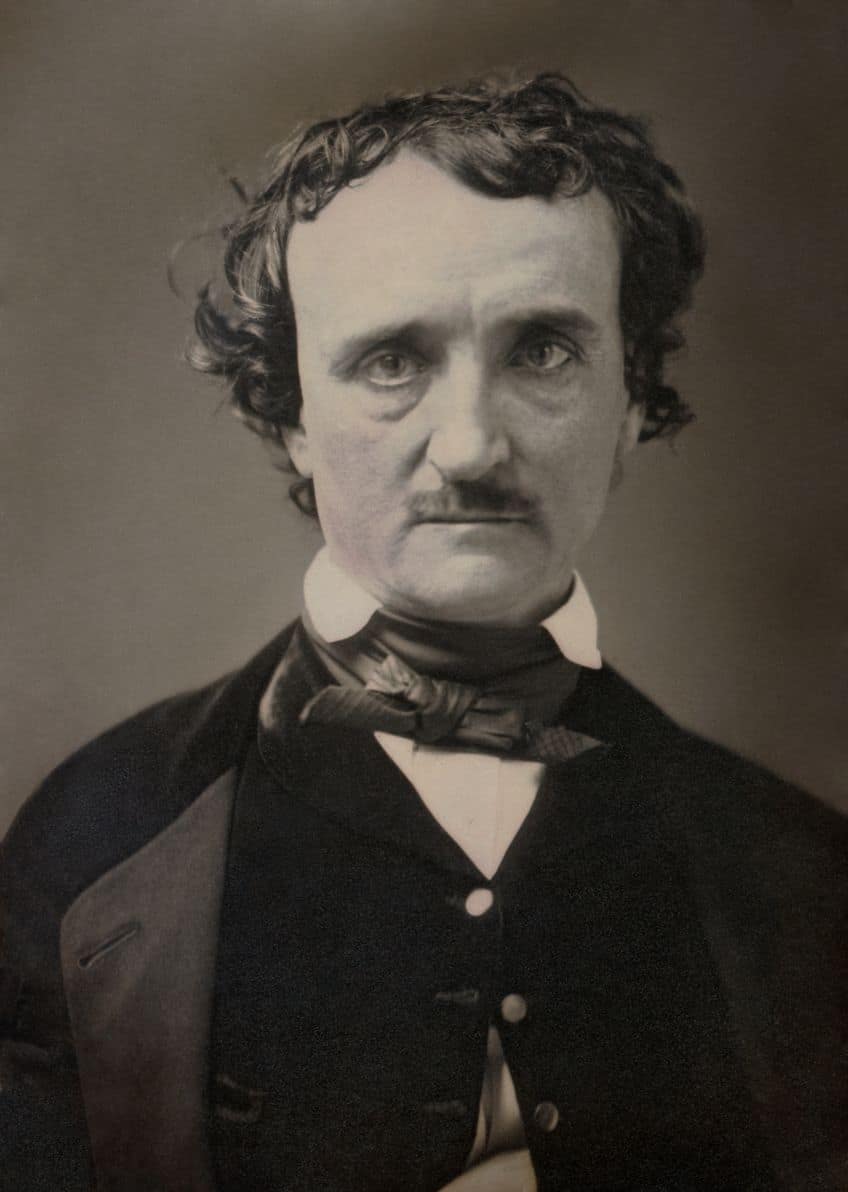
He is best known for producing texts that are rather dark and unhappy. He commonly explored themes like misery, depression, loss, death, and addiction. His works have become immensely influential in the development of gothic literature in general, but he is also seen as an important writer in the American Romantic tradition. His own life was also one of tragedy and an early death. The myth of Edgar Allan Poe may be even more famous than some of the texts that he produced.
However, that is all we need to know for now because we are about to dive into The Raven poem meanings that can be determined through an in-depth analysis of the text.
An In-Depth The Raven by Edgar Allan Poe Analysis
Before we get into the analysis of the poem itself. There should be a quick discussion of some of the more musical qualities of The Raven by Edgar Allan Poe. The poem is structured around eighteen stanzas, and each uses six lines with a trochaic octameter layout, for the most part. However, one of the most fascinating, and intricate, aspects of the musical form of The Raven is that it has a highly advanced rhyme scheme. The basic rhyme scheme is laid out as ABCBBB, but there is also internal rhyme that adds to this, and so the rhyme scheme could be amplified to instead be laid out as AABCCCBBB. This allows the poem to have a very complicated rhythmic structure. With that out of the way, let’s get to our in-depth The Raven by Edgar Allan Poe analysis with the very first verse of The Raven.
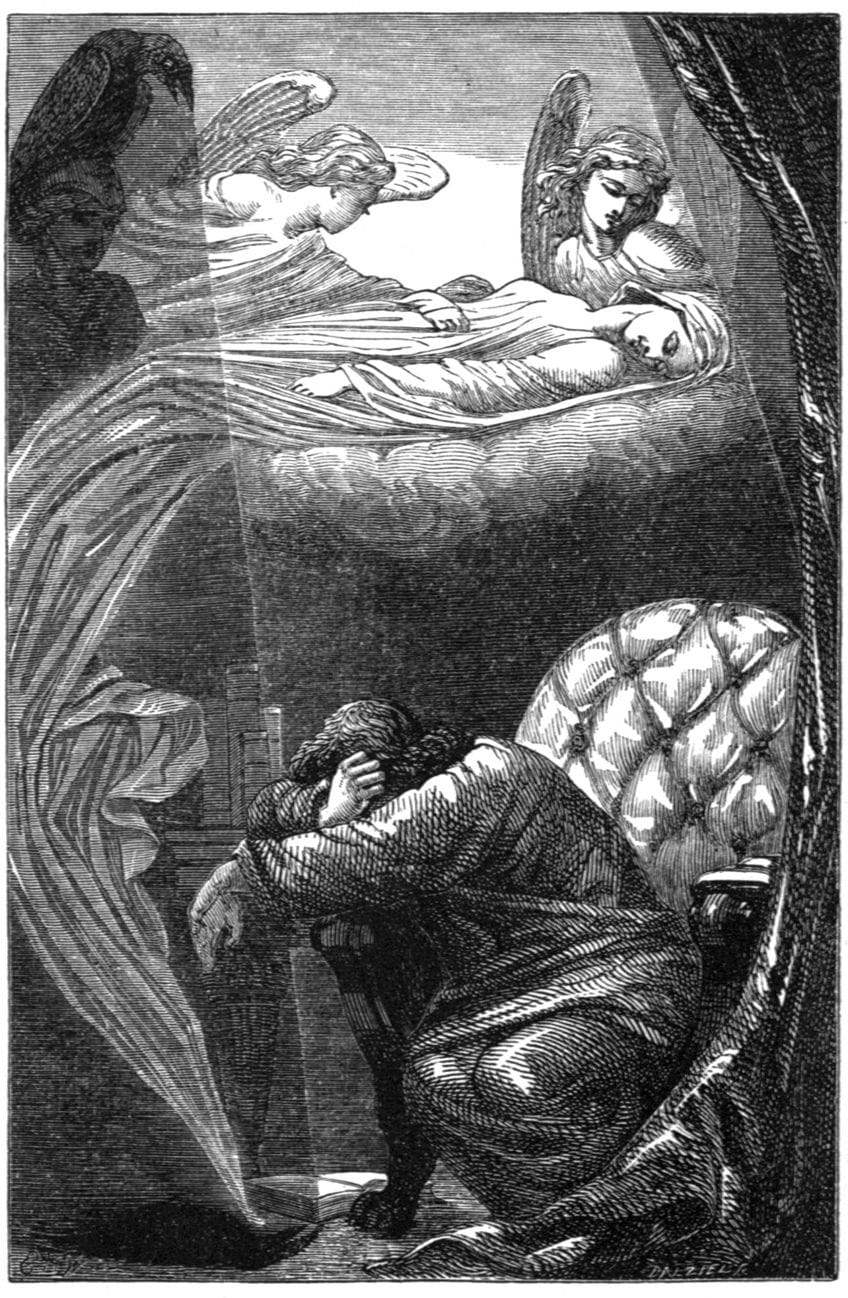
Stanza One
Once upon a midnight dreary, while I pondered, weak and weary,
Over many a quaint and curious volume of forgotten lore—
While I nodded, nearly napping, suddenly there came a tapping,
As of some one gently rapping, rapping at my chamber door.
“’Tis some visitor,” I muttered, “tapping at my chamber door—
Only this and nothing more.”
The first verse of The Raven is the most iconic part of the poem, and it serves as a powerful means of presenting the reader with the world that is about to unfold. It sets the scene with its “midnight dreary” phrase and it also establishes the mood of the poetic subject as he is “weak and weary”.
The heavy use of alliteration and consonance that can be found in this poem is evident from the very first line.
The gothic tone of the poem has been established as this character sits and reads old books or “forgotten lore”, and before he could fall asleep, something happens. The poem starts to make use of its heavy “p” and “ing” repetition here with words like “napping” and “rapping” being heavily repeated throughout the first verse of The Raven. This repetition will continue to be used as it emulates a sound that is made.
The first verse of The Raven also makes use of inverted commas for the dialogue. The man in his midnight reading is a character who can speak and discuss things, and this will become important throughout the poem as this is a narrative that is unfolding. This first verse of The Raven is the setup for what is soon to come, and with that, it transitions to the next stanza.

Stanza Two
Ah, distinctly I remember it was in the bleak December;
And each separate dying ember wrought its ghost upon the floor.
Eagerly I wished the morrow;—vainly I had sought to borrow
From my books surcease of sorrow—sorrow for the lost Lenore—
For the rare and radiant maiden whom the angels name Lenore—
Nameless here for evermore.
The protagonist of this dark and gothic tale spends the second stanza thinking about that night. He thinks about how he had wanted the morning to come so that he could stop thinking about his sorrow. The poem here mentions, for the first time, the figure of Lenore. Now, it may also be beneficial to note that there is a poem called Lenore by Edgar Allan Poe, and it concerns a woman who has died.
This Lenore has also died. For this reason, they may be the same person.
This Lenore is someone who is described as “rare and radiant” and someone that even the angels would discuss. She is a perfect thing to him. She was the love of his life, and she is now “lost” and so he feels immense sorrow. His midnight reading had been intended as a means of distracting himself from that sorrow. It is also here where we start with the rhyme associated with Lenore’s name as the final word is “evermore”. This will become an important recurring aspect of the poem.

Stanza Three
And the silken, sad, uncertain rustling of each purple curtain
Thrilled me—filled me with fantastic terrors never felt before;
So that now, to still the beating of my heart, I stood repeating
“’Tis some visitor entreating entrance at my chamber door—
Some late visitor entreating entrance at my chamber door;—
This it is and nothing more.”
The third stanza of The Raven by Edgar Allan Poe opens with a description of the curtains and their movement in the wind. It sets up the uncanny and uncomfortable mood of the story, and it uses words and phrases like “thrilled”, “fantastic terrors”, and “beating of my heart” to establish this gothic mood.
The anticipation builds as the man asks himself whether someone has come to visit him in the dead of night as they tap away.
He assumes that this is all that it is, but we know, from the tone that the poem has thus far established, that something else is happening here. We know that something is building. We know this because the poem is told from a later perspective. This man is looking back on this night, and that means the night is far from done, but what is going to happen? That is what the poem wants us to consider.
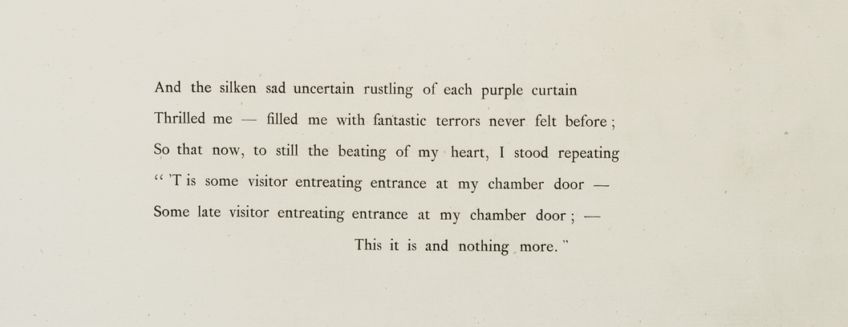
Stanza Four
Presently my soul grew stronger; hesitating then no longer,
“Sir,” said I, “or Madam, truly your forgiveness I implore;
But the fact is I was napping, and so gently you came rapping,
And so faintly you came tapping, tapping at my chamber door,
That I scarce was sure I heard you”—here I opened wide the door;—
Darkness there and nothing more.
The man has now left his room and gone to open the door for whoever his visitor is. He speaks as if everything is fine. There was no fear in him when he went to open the door because he had been in a daze before the noise of the tapping. He assumes that his disoriented state from before was nothing to worry about, and he was “hesitating then no longer”.
However, when he opens the door, there is nothing there.
There is little more than darkness. The stanza ends as he gazes out at the darkness. The anticipation of what will come mounts in this section, and the poem makes use of narrative techniques to accomplish this. We are not being told anything about what is out there, and the poem is elongating the amount of time that we are forced to wait for the reveal to occur. This is meant to build anticipation for what is to come.

Stanza Five
Deep into that darkness peering, long I stood there wondering, fearing,
Doubting, dreaming dreams no mortal ever dared to dream before;
But the silence was unbroken, and the stillness gave no token,
And the only word there spoken was the whispered word, “Lenore?”
This I whispered, and an echo murmured back the word, “Lenore!”—
Merely this and nothing more.
The man still stands at his doorway in this stanza. He stands there and gazes out into the darkness. The darkness is a common motif in the gothic and horror genres. We do not know what all goes bump in the night because we cannot see in the dark. That is what the poem is evoking when it does this. We are meant to wonder what is out there.
What is waiting in the darkness?
The character’s earlier bravery has started to wash away as he starts “doubting” what is out there. He finally does speak into the night, and he only says the word “Lenore” because part of him assumes that she must be the one out there. The sorrow and depression of his life have weighed down on him as he hopes that his dearly departed is the one who speaks to him from beyond the grave. All that returns to him is an echo of his own words. There is nothing for him to see in the dark night. He is alone.
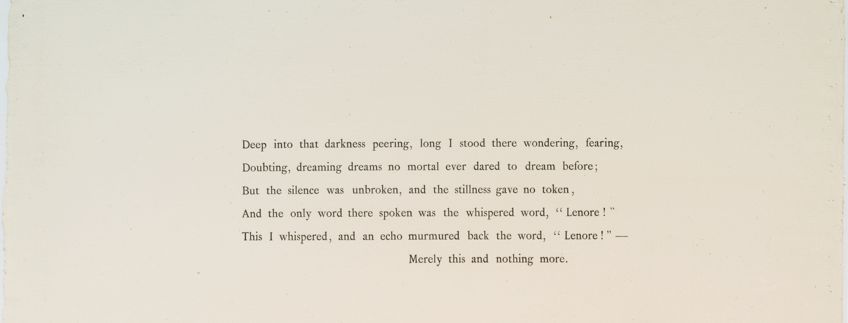
Stanza Six
Back into the chamber turning, all my soul within me burning,
Soon again I heard a tapping somewhat louder than before.
“Surely,” said I, “surely that is something at my window lattice;
Let me see, then, what thereat is, and this mystery explores—
Let my heart be still a moment and this mystery explore;—
’Tis the wind and nothing more!”
When the man returns inside and is clearly shaken from what has happened, which is described as “all my soul within me burning”, and then, out of the silence, comes a greater tapping. The narrative presentation of the poem continues in its use of an elongated period of unknown. We still have no idea what is in the darkness, but something taps again.
He assumes, this time, that it must be something tapping on his window.
The word “mystery” is repeated here to make us consider what it could be, and he even declares that it’s “the wind and nothing more!” He wants to convince himself that there is nothing else out there. He wants to convince himself that Lenore is outside the house tapping on the window to let her inside. He goes to the window while reassuring himself that this is the case.

Stanza Seven
Open here I flung the shutter, when, with many a flirt and flutter,
In there stepped a stately Raven of the saintly days of yore;
Not the least obeisance made he; not a minute stopped or stayed he;
But, with mien of lord or lady, perched above my chamber door—
Perched upon a bust of Pallas just above my chamber door—
Perched, and sat, and nothing more.
While the man has attempted to convince himself that there is nothing in the darkness, the use of the word “flung” to describe the opening of the window implies a desperate need to have a certain viewpoint asserted over others. He does not want to be right that there is something else out there. He wants it to be nothing. He wants it to be a dream.
However, a Raven enters the scene and his home.
Something important to note about this Raven as it perches itself on a bust and watches him is that its title is capitalized. It is not the “raven” but the “Raven”. This bird is a main character. This bird is important to the man as he watches it. The appearance of a raven is also an omen image. The raven is a creature that has long been associated with doom and death. It is a black and ominous bird, and as it stands and watches over him, he considers it.
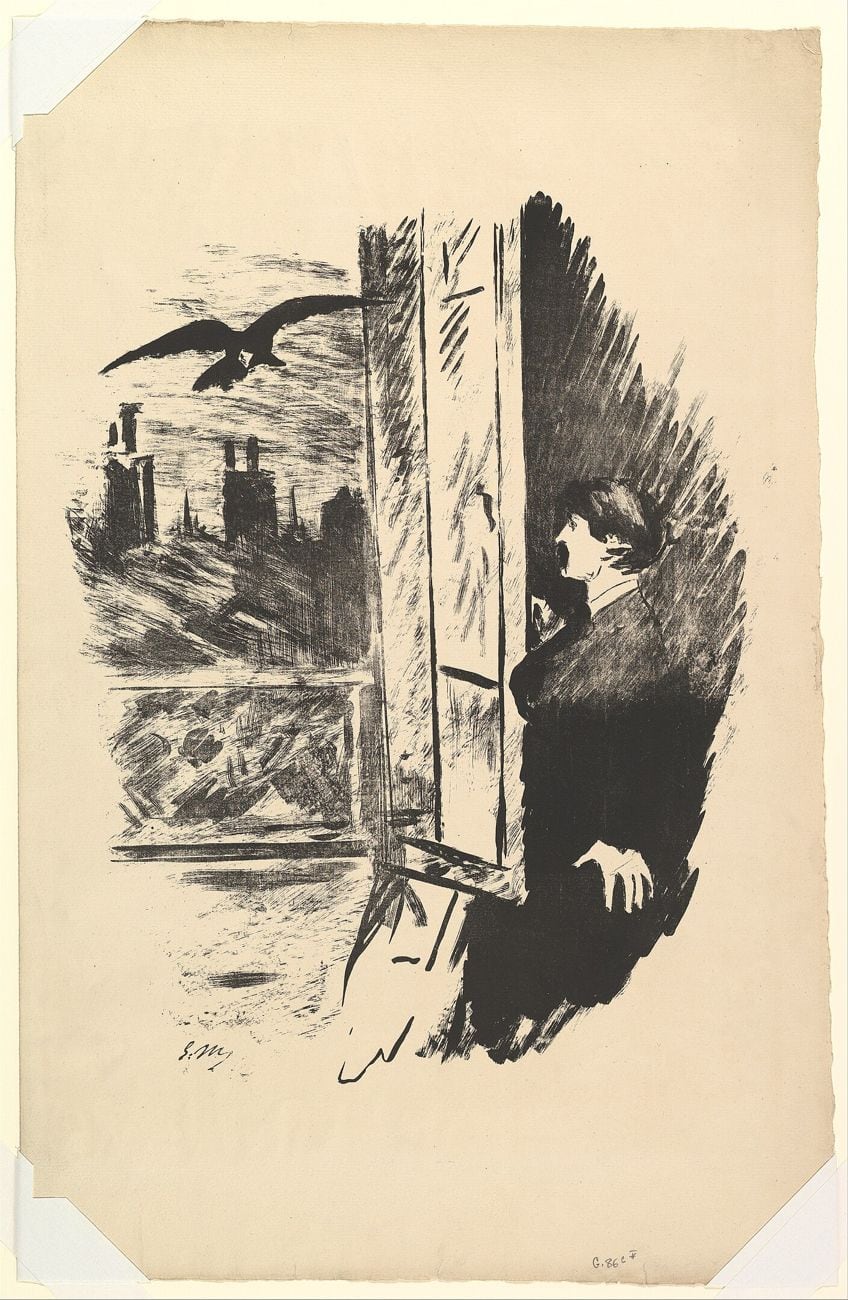
Stanza Eight
Then this ebony bird beguiling my sad fancy into smiling,
By the grave and stern decorum of the countenance it wore,
“Though thy crest be shorn and shaven, thou,” I said, “art sure no craven,
Ghastly grim and ancient Raven wandering from the Nightly shore—
Tell me what thy lordly name is on the Night’s Plutonian shore!”
Quoth the Raven “Nevermore.”
The man is, for a moment, happy to see the bird, and he smiles at it. However, the Raven is a creature that is “grave” and has a “stern decorum”, and he calls it a “ghastly grim” creature as he speaks to it. He also asks the Raven his name, and the Raven only responds with one word.
It does not respond with a name, but instead with the word “nevermore”.
The use of the word “nevermore” is of particular importance. This particular word is a rhyme on “Lenore”, and while the man cannot know whether or not the creature has done this on purpose, the appearance of a word that reminds him of the deceased lover that he mourns is a dark and depressing turn of events. We no longer need to have any anticipation over what has been knocking on his window, but we have a new anticipation: what is this bird doing here?

Stanza Nine
Much I marvelled this ungainly fowl to hear discourse so plainly,
Though its answer little meaning—little relevancy bore;
For we cannot help agreeing that no living human being
Ever yet was blessed with seeing bird above his chamber door—
Bird or beast upon the sculptured bust above his chamber door,
With such name as “Nevermore.”
The man immediately marvels at the bird. He is surprised to hear it speak so plainly in a human language. He had obviously assumed that the bird would either not be able to speak or it would have been the pet of some human and so learned its own name. However, the man thinks about how no bird would have a name like “nevermore”.
It cannot be a name, but the word is still one that strikes at him.
This introduction of the Raven serves to be an ill omen of what is to come, but we do know, because the story is told in retrospect, that the bird that has appeared does not harm him. He is still alive to tell this story, but what is the significance of a bird appearing in the home of the man? We are left with these questions as this stanza gives way to the next.

Stanza Ten
But the Raven, sitting lonely on the placid bust, spoke only
That one word, as if his soul in that one word he did outpour.
Nothing farther then he uttered—not a feather then he fluttered—
Till I scarcely more than muttered “Other friends have flown before—
On the morrow he will leave me, as my Hopes have flown before.”
Then the bird said “Nevermore.”
The Raven sits upon the bust and continues to only say that one word. The man contemplates that the solitary word that the bird can speak is one filled with all the Raven could muster from his soul. The word is a meaningful thing, but it has no direct meaning to the man. However, he starts to worry as he “mutters” at the bird. Nothing happens though. The bird does not leave.
The bird simply repeats “nevermore”.
The word has attained a certain gravity to it as the poem has continued. The creature continues in its use of that single phrase, and while the man has not yet said anything to the bird in anger or genuine fear, it does start to worry him as he watches the bird that stares down at him.

Stanza Eleven
Startled at the stillness broken by reply so aptly spoken,
“Doubtless,” said I, “what it utters is its only stock and store
Caught from some unhappy master whom unmerciful Disaster
Followed fast and followed faster till his songs one burden bore—
Till the dirges of his Hope that melancholy burden bore
Of ‘Never—nevermore’.”
The man, upon hearing the word again, and such a clear and perfectly pronounced word, starts to search for justification for why the Raven would know that word. He starts to tell himself that the Raven must have belonged to some “unhappy master” and that it does not know any other words. That must be the reason.
The word is, otherwise, so precise and pointed.
This particular stanza is a strong one for the development of the gothic tone of the poem. There is nothing supernatural afoot here, or at least nothing apparent, but it feels as if something supernatural is happening. We have all likely experienced a bird getting into our homes or an animal watching us, but does that mean something has happened? Does that mean something supernatural is going to happen? It’s likely pure coincidence, but it does not feel that way at the time, and humans are biased towards seeing signs in natural occurrences. However, in literature, it might not be a coincidence. What is this Raven that perches itself upon a bust and speaks only one word?

Stanza Twelve
But the Raven still beguiling all my fancy into smiling,
Straight I wheeled a cushioned seat in front of bird, and bust and door;
Then, upon the velvet sinking, I betook myself to linking
Fancy unto fancy, thinking what this ominous bird of yore—
What this grim, ungainly, ghastly, gaunt, and ominous bird of yore
Meant in croaking “Nevermore.”
The man now decides that there must be some reason for what is happening, and he sits himself down, watches the bird, and wonders. He is a man of learning, as we have learned from the very first verse of The Raven. We know that it is not unusual for someone like this to contemplate what is around him, and the bird is a mystery.
He asks himself what the creature meant by that single word.
The word is, once again, given central focus. The use of human language in animals is often considered to be a mimicry. The bird does not know what it says, it simply says a word that it heard somewhere. That must be it. The bird continues to croak that solitary word from its “grim, ungainly, ghastly, gaunt” body. The man wants to see this bird as something terrible, something from a horror story. But is it just a bird?

Stanza Thirteen
This I sat engaged in guessing, but no syllable expressing
To the fowl whose fiery eyes now burned into my bosom’s core;
This and more I sat divining, with my head at ease reclining
On the cushion’s velvet lining that the lamp-light gloated o’er,
But whose velvet-violet lining with the lamp-light gloating o’er,
She shall press, ah, nevermore!
The man sits in silence with the Raven before him. The poem continues to use higher-level expressions to relate this, such as by stating that he has engaged in “no syllable expressing” his thoughts rather than simply stating that he did not speak. He sees the Raven’s eyes as “fiery”, and this may be an expression relating to supernatural forces. However, he continues to contemplate. The Raven, like the man, also says nothing. Is the bird considering him as he is considering the bird?
We do not know the answer to this question.
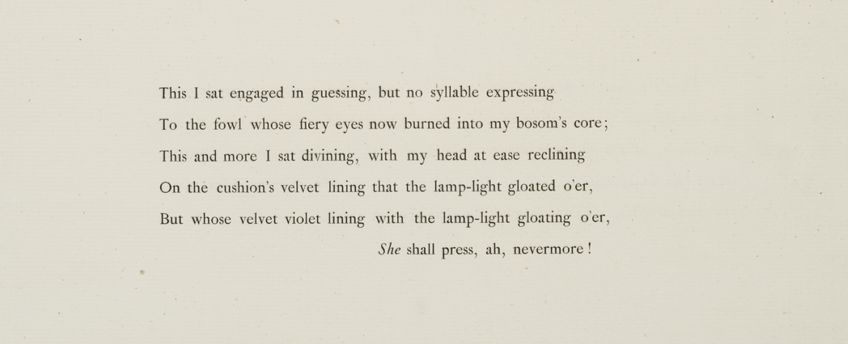
Stanza Fourteen
Then, methought, the air grew denser, perfumed from an unseen censer
Swung by Seraphim whose foot-falls tinkled on the tufted floor.
“Wretch,” I cried, “thy God hath lent thee—by these angels he hath sent thee
Respite—respite and nepenthe from thy memories of Lenore;
Quaff, oh quaff this kind nepenthe and forget this lost Lenore!”
Quoth the Raven “Nevermore.”
The man has attempted to remain cool, calm, and collected as he thought on this bird, but the Raven continues to remain quiet. He eventually cannot take it any longer and shouts at the bird. He shouts and calls the bird a “wretch”, which is an old term by today’s standards, but it does fit in with the gothic atmosphere of the poem. He starts to ask if god has sent the Raven to him. It is here where he finally makes the connection and utters the name of his lost love, Lenore.
The Raven only repeats the word the bird has said from the beginning.
This is a turning point in The Raven by Edgar Allan Poe, and an important stanza to note. Does the Raven know that he is tormenting this person? Does the Raven know that the one word he says is one that hurts this man? The man may be ascribing meaning where there is none, but neither he nor we know this to be the case. It may appear supernatural in nature, but things in the real world can also appear to be supernatural even when they aren’t paranormal in the slightest.
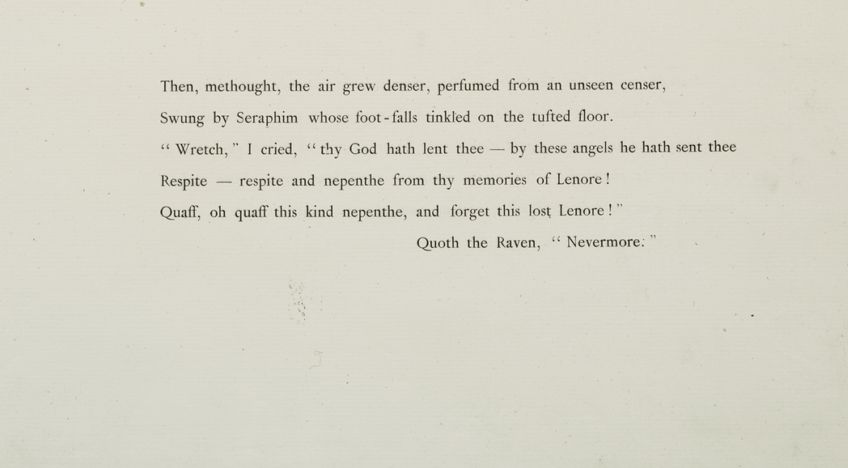
Stanza Fifteen
“Prophet!” said I, “thing of evil!—prophet still, if bird or devil!—
Whether Tempter sent, or whether tempest tossed thee here ashore,
Desolate yet all undaunted, on this desert land enchanted—
On this home by Horror haunted—tell me truly, I implore—
Is there—is there balm in Gilead?—tell me—tell me, I implore!”
Quoth the Raven “Nevermore.”
The man, by this point, has given in to his emotions as he screams at the bird. He calls it “a thing of evil” and even asks if it is a “bird or devil”. He asks if the bird was sent by someone, if it has come to torment him, to hurt him, to beat him with the one word that he does not want to hear.
The bird only responds with that one word: Nevermore.
This is another important stanza because it connects to the man’s breakdown. He has held in his sorrow over the loss of Lenore for so long, and he is finally being confronted with that. The bird, whether by supernatural forces or happenstance, has come to challenge his sorrow and to attack it.

Stanza Sixteen
“Prophet!” said I, “thing of evil!—prophet still, if bird or devil!
By that Heaven that bends above us—by that God we both adore—
Tell this soul with sorrow laden if, within the distant Aidenn,
It shall clasp a sainted maiden whom the angels name Lenore—
Clasp a rare and radiant maiden whom the angels name Lenore.”
Quoth the Raven “Nevermore.”
The man repeats himself in this stanza. He asks the bird about Lenore. He has become convinced that the bird is a messenger of some kind, and he wants to speak to the Heavens about Lenore. This is a continuation of his breakdown, and the bird says nothing but that one word again. Religious imagery of angels is evoked here to once again draw a connection between Lenore and Heaven itself.
She is meant to be a perfect thing to him, and a perfect thing would have come from and returned to Heaven.
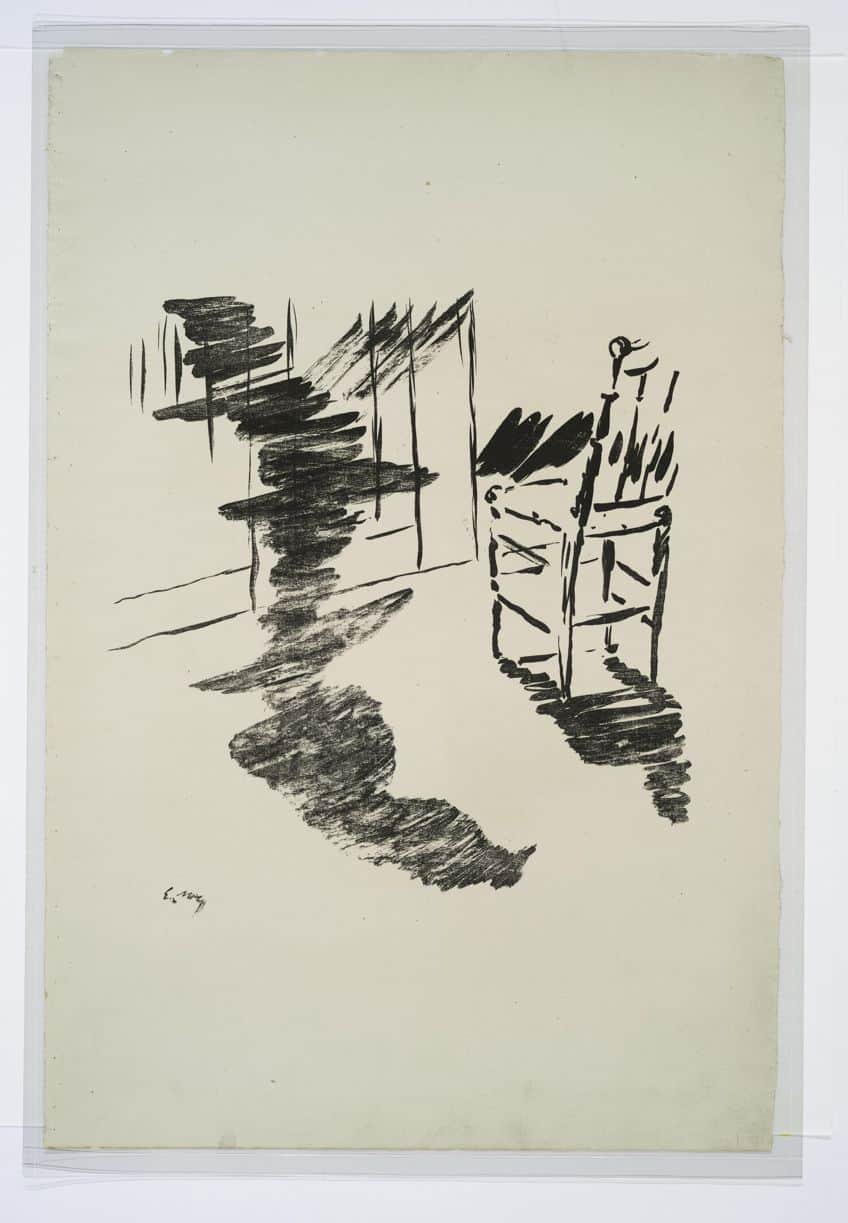
Stanza Seventeen
“Be that word our sign of parting, bird or fiend!” I shrieked, upstarting—
“Get thee back into the tempest and the Night’s Plutonian shore!
Leave no black plume as a token of that lie thy soul hath spoken!
Leave my loneliness unbroken!—quit the bust above my door!
Take thy beak from out my heart, and take thy form from off my door!”
Quoth the Raven “Nevermore.”
The man’s breakdown finally comes to an end as he implores the Raven to leave that place. He wants to be away from the memory of Lenore that the bird represents. He even begs the Raven to “take thy beat out my heart” because the bird’s word has hit him hard, and it has harmed him immensely. He wants to be free of this bird and what the bird represents.
He does not want to hear that word again.

Stanza Eighteen
And the Raven, never flitting, still is sitting, still is sitting
On the pallid bust of Pallas just above my chamber door;
And his eyes have all the seeming of a demon’s that is dreaming,
And the lamp-light o’er him streaming throws his shadow on the floor;
And my soul from out that shadow that lies floating on the floor
Shall be lifted—nevermore!
The Raven remains and watches him. Its shadow is cast upon the floor, and the man’s experience with it finally comes to an end. What did the Raven’s visit mean for the man? Was the Raven a messenger from some other place or was the Raven simply a coincidental visitor who happened to terrify the man and bring him face-to-face with the name of the woman he lost? We will never know the answers to these questions, but your interpretation may speak differently if you perform your own The Raven by Edgar Allan Poe analysis. What do you think the Raven’s appearance meant?

What is The Raven about and why does it deserve to be analyzed? Hopefully, this article has given a good and detailed analysis of the poem to help understand the answer to that question. This The Raven by Edgar Allan Poe analysis opened with a biography of the poet and a summary of The Raven by Edgar Allan Poe, before moving into an in-depth analysis of the poem. Altogether, this should be a helpful analysis for those who are interested in this famous Gothic poem. However, there are many other Edgar Allan Poe poems worth exploring and analyzing.
Frequently Asked Questions
What Is The Raven by Edgar Allan Poe?
The Raven by Edgar Allan Poe is a poem by one of the most famous American Romantic writers. The poem is considered to be one of the most important in the Gothic literature tradition and is especially noted for its use of a highly musical style. The poem is generally seen as a stylistic masterpiece. In addition, it is considered to be one of the most widely read and taught American poems. This poem can be found in high school and university curricula around the world.
Who Was Edgar Allan Poe?
Edgar Allan Poe was an American writer. While The Raven is one of the most famous texts that he ever wrote and, arguably, the most famous one too, it is far from all he is known for writing. He had a relatively short but prolific career before dying quite young, and he left behind a large body of poems, short stories, and pieces of criticism. One of the greatest contributions that he provided to the literary world was that he created the first detective fiction which is commonly considered to be the originator of the form. This means that without him there would be no Sherlock Holmes.
What Is The Raven About?
The Raven by Edgar Allan Poe is about loss and grief. The poem tells the story of a man who, in the dead of night, is visited by an ominous bird, a raven. The creature repeatedly utters a single word to him, a word that sounds like the name of his lost love. The Raven poem’s meanings are focused on understanding and exploring the feelings that this man is forced to experience as he contends with this incessant raven.
What Are Some of the Other Most Famous Poems by Edgar Allan Poe?
While The Raven by Edgar Allan Poe is, by far, the most famous of all the poems that Edgar Allan Poe ever produced, it is far from the only one that he wrote. He wrote many other fantastic poems throughout his career, and some of the most notable include poems like Tamerlane (1827), Lenore (1843), and The City in the Sea (1845). Other than these, there are many others that are also worth exploring, reading, and analyzing.
What Major Themes Did Edgar Allan Poe Often Explore?
The Raven is likely a good distillation of some of the themes that Edgar Allan Poe would often explore, as many of his works, of both prose and poetic varieties, were concerned with darker issues. Many of these themes included loss, death, sadness, depression, and addiction. However, he also produced a few texts that were more uplifting, such as the comedies that he wrote, but these are not considered to be his most famous texts, and he is instead generally known for those far darker themes and ideas.
Justin van Huyssteen is a freelance writer, novelist, and academic originally from Cape Town, South Africa. At present, he has a bachelor’s degree in English and literary theory and an honor’s degree in literary theory. He is currently working towards his master’s degree in literary theory with a focus on animal studies, critical theory, and semiotics within literature. As a novelist and freelancer, he often writes under the pen name L.C. Lupus.
Justin’s preferred literary movements include modern and postmodern literature with literary fiction and genre fiction like sci-fi, post-apocalyptic, and horror being of particular interest. His academia extends to his interest in prose and narratology. He enjoys analyzing a variety of mediums through a literary lens, such as graphic novels, film, and video games.
Justin is working for artincontext.org as an author and content writer since 2022. He is responsible for all blog posts about architecture, literature and poetry.
Learn more about Justin van Huyssteen and the Art in Context Team.
Cite this Article
Justin, van Huyssteen, ““The Raven” by Edgar Allan Poe Analysis – Taking a Closer Look.” Art in Context. October 30, 2023. URL: https://artincontext.org/the-raven-by-edgar-allan-poe-analysis/
van Huyssteen, J. (2023, 30 October). “The Raven” by Edgar Allan Poe Analysis – Taking a Closer Look. Art in Context. https://artincontext.org/the-raven-by-edgar-allan-poe-analysis/
van Huyssteen, Justin. ““The Raven” by Edgar Allan Poe Analysis – Taking a Closer Look.” Art in Context, October 30, 2023. https://artincontext.org/the-raven-by-edgar-allan-poe-analysis/.


